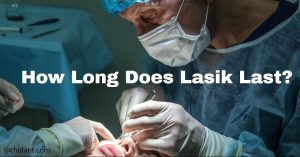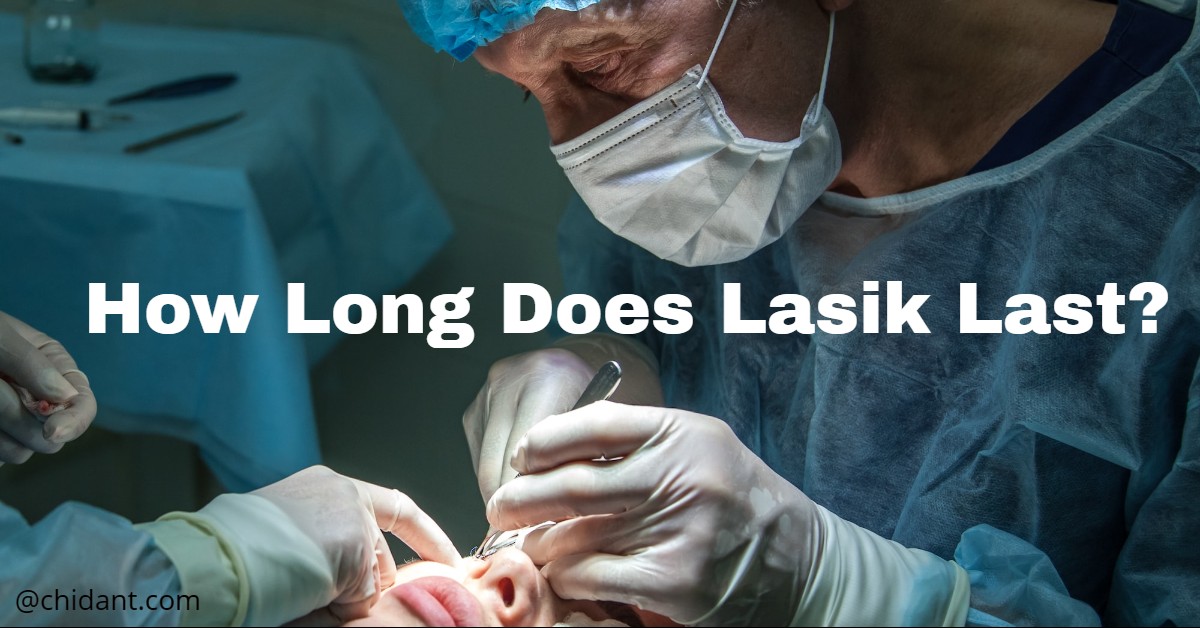How Long Does Lasik Last? Hey! welcome to chidant.com. Today we’ll be talking about how long Lasik lasted. This article outlines a few points you need to note about Lasik.
Though the results of LASIK surgery are long-lasting, patients may see diminishing returns with time. In most cases, LASIK corrective surgery yields permanent improvement in vision. Anatomical variations in the eye(s) will necessitate an augmentation procedure for about 10–12% of individuals nationwide.
What is Lasik?
LASIK is a form of refractive surgery used to treat nearsightedness, farsightedness, and astigmatism by altering the shape of the cornea. When contemplating whether or not to get LASIK done, one common concern is whether or not the results would be permanent.
The good news is that LASIK permanently modifies the cornea. However, there are more factors to think about. As an example, as we age, our eyesight may shift. You may be thinking, “How long do LASIK results last?” All the information you need is included in this article.
How Long Does Lasik Last?
The laser in LASIK is used to restructure the cornea, making glasses and contact lenses unnecessary for many people. Between 2015 and 2022, the annual number of LASIK procedures in the United States rose by 124,000, and further growth of 6.48 percent is predicted between 2022 and 2025.
Surgeons in the United States will improve vision correction options as the LASIK procedure continues to gain popularity.

LASIK Eye Surgery
One of the most common outcomes of LASIK is a rapid and dramatic enhancement of visual acuity. The outcome of your LASIK eye surgery can be evaluated within a few weeks. Most patients are spot on, but those who are over or under-corrected after surgery may benefit from an adjustment.
In terms of LASIK eye surgery outcomes over the long term, visual variations may occur due to the eyes changing over time. This is why doctors insist on your vision being steady for quite some time before they operate on you. Teenagers, for instance, would not be suitable candidates for a surgery that delivers lasting results since their refractive defect might fluctuate as their eyes develop.
Additional: Best Hospitality Schools.
Therefore, LASIK outcomes do not alter after ten years, but your eyes may. Is permanent vision correction possible with LASIK? Yes, but only if your eyes don’t know the age, which, as you’ll see, is highly unlikely.
There are two primary phases of LASIK surgery.
- To create a stir by making a fuss.
- They are recontouring the corneal tissue behind the flap with a laser.
The operation aims to reduce the need for corrective eyewear like spectacles and contact lenses. An eye drop is used to numb the eye before LASIK surgery. In most cases, a sedative is also administered to the patient. The sedative will put the patient at ease, and they will be able to sleep better after the operation. The whole thing has a quick turnaround time of around 10 minutes.
How Old Do You Have To Be To Get LASIK
Whether or whether LASIK is an option for you may have you asking what the minimum age is. Although the FDA recommends that patients be at least 18 years old before undergoing LASIK, most patients are between the ages of 30 and 45. Whether or not they’ve had corrective eye surgery, patients will experience the aging effects of presbyopia around age 40.

What Vision Changes Occur After LASIK?
Changes in the eyes over time can cause variations in the final LASIK results. Presbyopia is a major shift in eyesight that affects everyone, and it typically starts in one’s forties. This causes our eyes to lose their capacity to concentrate, necessitating the usage of reading glasses even after LASIK has been performed.
A later-in-life onset of ocular disease is another potential source of vision loss. Some of the most typical examples of these conditions are:
- Cataracts result from a gradual yellowing of the crystalline lenses of the eyes. Vision problems such as blurriness, poor night vision, halos, glare, and trouble distinguishing colors are all possible side effects of cataracts. Cataracts can still form in the future, even after LASIK surgery. Cataracts are treated through surgical removal and replacement of the affected lens.
- The optic nerve can be damaged by a series of diseases known as Glaucoma. It used to be linked to elevated IOP, but now it always is. Damage to peripheral vision is one of the symptoms of Glaucoma. Medication, laser therapy, or surgery are all options for treatment.
- High myopia is associated with an increased risk of retinal detachment, and this danger is not addressed with LASIK surgery. The overall length of the eye, unaffected by corneal surgery, is the root cause of the increased risk. Surgery is used to repair retinal detachments.
There will be some vision changes after LASIK surgery, but many years of good eyesight can be gained before these issues become noticeable.

Why you need Lasik
In most cases, LASIK is a once-and-done procedure. In most instances, the desired level of vision is obtained during surgery, and precise measurements are taken in advance. However, certain people either don’t get enough or do too much correction. When this occurs, another LASIK procedure—sometimes dubbed an “enhancement”—may be required.
Only 1-2% of people will need this the first year after surgery. Similar to the original LASIK treatment, enhancement surgery involves lifting the preexisting flap and applying laser ablation to the underlying tissue.
If your eyes change over time, you may need a LASIK retreatment. About 1% every year is added to the enhancement rate. This means that after 20 years, up to 20% of patients may require a LASIK improvement. You’ll have 20 years of experience with good eyesight by then.
How Long Does LASIK Eye Surgery Last?
No one can say how long the results of LASIK surgery will last. Though the results of LASIK surgery are long-lasting, patients may see diminishing returns with time.
In most cases, LASIK corrective surgery yields permanent improvement in vision. Anatomical variations in the eye(s) will necessitate an augmentation procedure for about 10–12% of individuals nationwide.

In summary, permanent corneal reshaping is accomplished with LASIK, improving eyesight that typically lasts long. There are times when cosmetic surgery is required. Vision correction or surgery may be required later in life for presbyopia and cataracts. The ability to foresee potential outcomes is enhanced by such knowledge.

